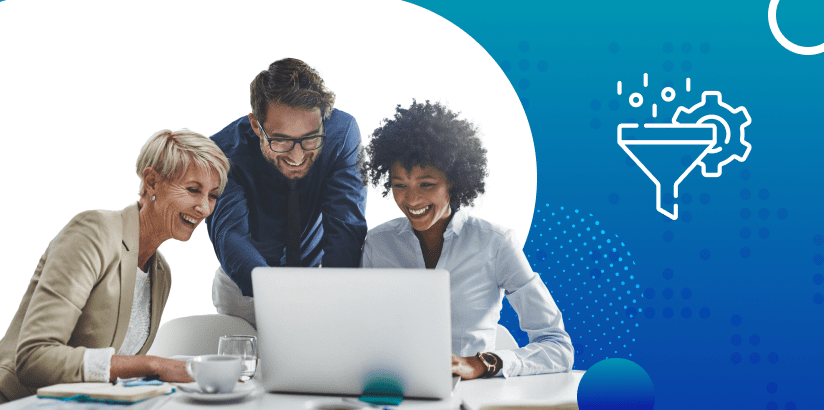In some product categories, the purchase journey is short and sweet. Consider a consumer going to a grocery store to buy cereal. They weigh their options for a few minutes, and then they make their selection.
The B2B customer journey, on the other hand, is often a lot more complicated. The B2B sales funnel is a common way to illustrate this complex journey.
But what is a sales funnel?
In this post, we’ll explore everything you need to know about B2B sales funnels. We’ll start with the basics, like what a sales funnel is and what the B2B sales funnel stages are. Then, we’ll share practical tips for optimizing your sales funnel to drive better results.
What is a sales funnel?
First things first: what is a sales funnel?
A sales funnel is a high level model of how prospective buyers move through the purchase journey. It illustrates their entire journey – from initially learning about a brand to making a purchase.
A B2B sales funnel is a funnel that specifically illustrates how B2B prospects move through the purchase journey.
As you probably guessed, sales funnels are depicted in the shape of a funnel; they’re wider on top and gradually become more narrow. Typically, sales funnels are labeled by stage. Some use general stages, like:
- Top of funnel: Early parts of the purchase journey
- Middle of funnel: Middle parts of the purchase journey
- Bottom of funnel: Late parts of the purchase journey
Other sales funnels are labeled with more specific stages, which we’ll explore later.
B2B sales funnels are a useful tool for sales teams to determine where their prospects are in the purchase journey. Then, sellers can use a sales playbook to engage any buyer, no matter what stage of the sales funnel they’re in. This will increase sales acceleration. In other words, sales reps will be able to move more prospects through the sales funnel – faster.
Of course, not every prospect follows the same purchase journey. While some prospects progress through each sales funnel stage, others take a less linear path. For example, a prospect might proceed through the sales funnel – but then realize the specific product they’re considering isn’t the right fit for them. So, they may jump back up to earlier stages of the funnel as they consider their other options.
As such, a sales funnel should be seen as a broad overview of the purchase journey rather than a rigid set of steps prospects must complete.
What are the stages of a B2B sales funnel?
A quick Google search will show you many B2B sales funnel examples. Not every revenue organization uses the same B2B sales funnel.
As we mentioned earlier, some B2B sales funnels use general terms for the parts of the sales funnel – like top of the funnel, mid-funnel, and bottom of the funnel. Others use more specific terms to describe the stages of the B2B sales funnel.
While each B2B sales funnel is different, certain stages are common.
Stage #1: Awareness
Awareness is the first stage of the purchase journey. As you probably guessed, it’s the stage when prospects become aware of your brand.
There are many ways a prospect may become aware of your brand. Often, the marketing team owns these awareness-stage initiatives.
For example, a prospect may see a paid post on LinkedIn, promoting an upcoming thought leadership webinar focused on industry trends. Or one of your blogs might show up in Google search results when the prospect searches for solutions to solve one of their pain points.
Stage #2: Interest
The prospect is now aware of your brand. The next challenge is to build their interest.
During the interest stage of the B2B sales funnel, brands must build relationships with potential customers and help them see the impact their challenges have on their effectiveness and efficiency. At this point, the prospect isn’t ready to buy, so it’s best to avoid delving into the ins and outs of your product offerings.
There are several channels organizations can use to build prospect’s interest, including:
- Blogs
- Webinars
- Ebooks
- Email campaigns
Stage #3: Consideration
During the consideration stage, prospects know they have a problem and are actively seeking a solution.
During this stage, sales and marketing become more focused on the product. For example, marketing teams may develop case studies that convey how customers have used specific products and services to overcome their challenges.
Stage #4: Intent
During this stage, buyers take action that demonstrates their intent to purchase. They know they want to buy but are unsure which brand or product best suits them.
For example, a prospect might reach out to a sales rep to ask questions. Or, they might schedule a live demo.
Demos – one-on-one or in a group webinar format—are important tools at this stage of the B2B sales funnel. Some revenue organizations also offer “self-guided tours,” which allow prospects to better understand the ins and outs of a product or service.
Stage #5: Evaluation
The evaluation stage of the sales funnel is when the prospect weighs their options and makes a purchase decision. Prospects make their decision based on all the information they’ve gotten up to this point – including:
- Sales collateral
- Sales battle cards
- Pricing information
- Demos
- Free trials
- Testimonials and reviews from existing customers
Negotiations are common at the evaluation stage of the sales funnel.
Stage #6: Purchase
You’ve been working toward this stage. It’s when the prospect signs a contract and officially becomes a customer.
Of course, that doesn’t mean the work is over. It’s important to ensure the customer has an excellent implementation experience and feel supported during the initial rollout and throughout their relationship with your company. This will boost satisfaction – and customer retention.
B2B sales funnel vs. B2B sales pipeline
Sales funnel and sales pipeline are two phrases often used interchangeably. While they have similarities, they aren’t the same.
A sales funnel is a visual representation of the stages a buyer goes through during their purchase journey. However, buyers aren’t required to go through every stage of the B2B sales funnel to make a purchase.
Sales pipelines are visual representations of the B2B selling process. They include every stage of the sales process – from prospecting to retention. B2B sales pipeline management is the process of overseeing the sales pipeline.
Prospects may skip stages of the sales funnel. However, sales reps can’t skip stages of the sales funnel. Each step is required in the sales process.
B2B sales funnel vs B2C sales funnel: What’s the difference?
B2B and B2C customers navigate a journey before making a purchase. As such, both B2B and B2C businesses can use sales funnels to illustrate these journeys.
But B2B and B2C sales funnels aren’t the same.
B2B sales are typically more complex than B2C sales. In B2B deals, there is usually more money on the line and more people involved in the evaluation process. So it’s unsurprising that the B2B sales cycle often takes much longer than the B2C sales cycle.
As such, B2B SaaS sales funnels are typically more complex than B2C sales funnels. B2B sales funnels are often longer and incorporate more stages. In addition, B2B buyers often spend more time in each stage of the sales funnel than their B2C counterparts.
| B2B Sales Funnel | B2C Sales Funnel | |
|---|---|---|
| Overall funnel length | Longer | Shorter |
| Amount of time spent in each stage | More | Less |
| Number of stages | More | Fewer |
Tips to improve your B2B sales funnel
Perhaps you’ve never created a B2B sales funnel. Or maybe your revenue organization uses one, but it’s not working.
Whatever the case, there’s always room for improvement.
Let’s explore some tips for creating (or improving) your B2B sales funnel.
Leverage data to understand the customer journey
There are plenty of B2B sales funnel examples out there. But they may not be relevant to your business.
It is important to leverage data to understand how your customers navigate the purchase journey. Then, you can use those insights to develop a relevant B2B sales funnel for your business.
Identify your ideal customers
You may have many people in your B2B sales funnel, but you’ll be wasting your time if they aren’t a good fit for your products and services.
It’s important to document your ideal customers. A great starting point is to analyze your existing customer base.
Then, you can develop buyer personas, which will help inform content development. Buyer personas will also help your sales reps prioritize their time on good-fit prospects.
Align sales and marketing
All too often, sales and marketing teams act in silos. They each focus on their initiatives without much insight into what the other team is doing.
This misalignment causes big problems in the B2B sales funnel.
For example, your marketing team may devote much time to developing webinars and reports. But the leads that result from these initiatives may never convert. Without this feedback, marketing teams will continue doing what they’re doing, and sellers will continue getting unqualified leads.
Instead, sales and marketing teams must act as partners. That way, marketing can prioritize content and campaigns that attract the right people and guide them through the sales funnel. And, sales will get qualified leads that are more likely to become customers.
Develop content for each stage of the B2B sales funnel
Modern B2B buyers depend on content to make informed purchase decisions. But generic content won’t cut it. Instead, sellers need content that’ll resonate with each customer – no matter where they are in the B2B SaaS sales funnel.
Sales and marketing teams should collaborate to develop content for sellers during each sales funnel stage. All content should be stored in a single content management system so sellers can easily find the right sales content for each sales scenario.
Ensure sellers know how to use content
You might have great sales content. But if your sellers don’t use it (or don’t know how to use it), it won’t help you close more deals.
Be sure to provide training and enablement to help sellers learn how and when to use key content assets. In addition, be sure they know exactly where to find the content they need. That way, they’ll spend less time searching and more time building relationships with prospects.
Prioritize good fit leads
Salesforce research found that sales reps spend only 28% of their time selling. The rest is spent on internal meetings, data entry, and other manual tasks.
Research found that reps only spend
Because sales reps have such limited time, they need to prioritize prospects who are a good fit for their products and services. For starters, marketing teams must ensure their initiatives are actually yielding high-quality leads. In addition, sales reps should know their ideal customer profiles inside and out and have the skills needed to quickly determine whether or not a prospect is a good fit.
Don’t check out after the deal is closed
You might think the work is done once the prospect has signed the dotted line. Well, think again.
Instead, revenue organizations should continue to engage with customers. For example, they could invite them to a webinar where another customer shares how they use a specific product feature. Or, they could add them to an email campaign that shares tips for making the most of their investment.
Staying engaged with customers will increase their satisfaction. That means they’ll be more likely to stay a customer – and recommend your company to those in their network.
Analyze and optimize your sales funnel regularly
Your sales funnel shouldn’t be set in stone. Instead, it’s important to track B2B sales funnel metrics. For example, measure prospects’ conversion rates at each stage of the B2B sales funnel. Then, use that data to make optimizations.
Engage with buyers – wherever they are in the B2B sales funnel
A B2B sales funnel is a great tool for visualizing the B2B purchase journey. When sales reps understand where buyers are in their journey, they can better determine how to engage with them.
Mindtickle’s integrated revenue enablement platform equips your entire revenue team with the training, enablement, content, and call insights they need to deliver outstanding experiences across the sales funnel – and close more deals.
Training, enablement + Content In Mindtickle
Ready to see firsthand why companies are choosing Mindtickle?
Get Your Demo







